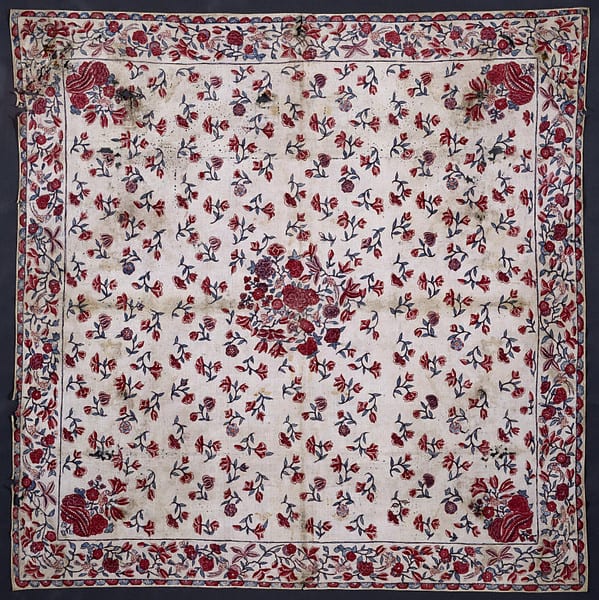
Handkerchief, Pulicat, Coromandel Coast, India, 1700s, Painted and dyed cotton in flower sprigged patter. IS.166-1950. Victoria & Albert Museum.
As an East India Company official in Madras, Richard Benyon understood and valued objects. The preparations he made for his final journey to England in 1744 demonstrates the different ways in which Benyon used objects and his material knowledge to display affection and affirm familial ties. Letters between Richard and his brother Charles reveal that Richard bought a range of objects back from India to England with him when he boarded the Duke in 1744. Among the many objects he listed as accompanying him were a lacquered Chinese tea chest, two chests of drawers, a bureau, and various linens, waistcoat and books. Benyon also returned with china ware, which he described as ‘Cistern’ china ware and some perishable items, such as tea.[1] Alongside the objects he brought home with him he also invested time in arranging for the return and distribution of particular objects to specific individuals. Richard asked his brother Charles to help him in this task and looked to him to facilitate many aspects of the return, at the same time he also called upon the resources of Captain Hanslapp. Captains acted as important mediators in the transferral of objects back to Britain for East India Company officials and their families. (See the Valentines Case Study)
Benyon charged his brother with a range of gifts for his daughter Molly and her carer Mrs Drake. His description of these objects and his methods for choosing them demonstrate that Benyon not only had good connections, he also understood material objects. He describes how he had bought Molly a ‘flower’d Apron and Handkerchiefs’ along with three petticoats.[4] The flowered handkerchief he procured for Molly would have displayed the vibrancy of the one shown in the image above. Similarly, he bought ‘two flower’d Aprons, six striped Aprons, and One piece of flower’d Caps marked with & for Mrs Drake.’[5] Benyon’s attention to detail regarding Molly’s presents is somewhat surprising. Despite Benyon’s absence from England for eleven years, he was able to buy an apron, handkerchiefs and a set of petticoats specifically because he thought they would ‘match some of the same sort left in one of the Chests at home’.[6] For Benyon these objects were intimately linked to the domestic spaces of home and he retained a detailed memory of them. His writings demonstrate his connections, in-depth knowledge of materials and his detailed remembrance of Molly’s material world. By marking these objects out as particular and special through his knowledge and care, Benyon used these objects to express affection across space and time.
[1] Berkshire Record Office, Papers of R. Benyon inc. letters with brother and list of clothing
D/EBy/B7 (1708-1757).
[2] Many thanks to Margaret Makepeace of the British Library for suggesting this source.
[3] Berkshire Record Office, Papers of R. Benyon inc. letters with brother and list of clothing, D/EBy/B7 (1708-1757). Letter from Richard Benyon to Charles Benyon, 12 January 1743/4.
[4] Papers of R. Benyon inc. letters with brother and list of clothing, D/EBy/B7 (1708-1757). Letter from Richard Benyon to Charles Benyon, 12 January 1743/4.
[5] Ibid.
[6] Ibid.